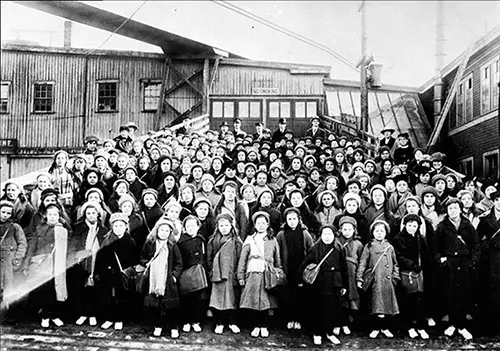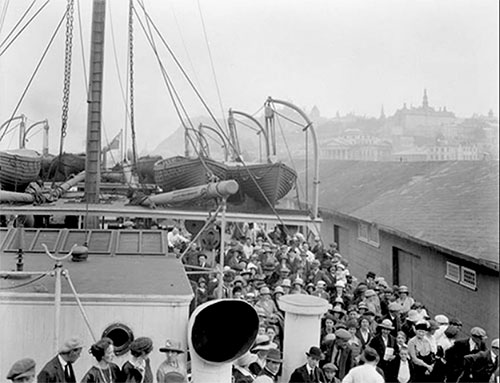Canada's Attitude Toward Immigration

British Immigrant Children At Landing Stage - Saint John, NB. nd. ca. 1910. Library and Archives Canada, GGA Image ID # 14a60bbb42
The Dominion still wants agricultural immigrants and aids them with loans, but the United States law restricting immigration complicates the whole problem—Signs that the European tide will seek to make Canada a gateway to the United States.
Effect of US Immigration Policy
WHETHER or not the United States decides to prolong its new curb on immigration for two or three years, or forever, there is no sidestepping one thing—Canada will be very vitally affected.
The United States is sometimes apt to think that it is the only nation in North America which participates in the vast annual movement of humanity, or that it alone has immigration problems.
Canada, however, in the last ten years has received close to two and a half million immigrants—a small number, of course, compared to the million a year which the United States has received in some years, but a severer test when you remember that these two and a half million have had to be absorbed into a nine-million population.
The United States, again, has never officially advertised its attractions in order to get immigrants; Canada has, for several years.
Whatever way the United States moves in regard to immigration, there will be a certain sympathetic reaction in Canada, for both nations have toward European problems an indefinable similarity of principle, even if not always of conduct.
But if the United States bars immigrants Canada must also bar them, for otherwise the human stream will merely be diverted in their destination, and will find its way in at Montreal or St. John instead of at New York.
The result would be a disaster to Canada, in spite of her greater power of absorption, due to the thinner population. It does not want, and could not stand, the strain of adding a million a year to its population, even if they all were—which is impossible—immigrants of the only kind that Canada advertises for, namely, agricultural settlers, who are wanted to develop the vast idle lands of the Northwest.
The Nordic Immigrant to Canada
So far Canada has been very fortunate in her immigrants. They have been drawn almost exclusively from the " Nordic " peoples (to use the modern phraseology of the anti-immigrationist); the somewhat colder climate of Canada has repelled the Southern Europeans.
Nearly 900,000 of the ten-year 2,500,000 were, for example, citizens of the United States, and about 800,000 were ex-residents of the British Isles.

British Immigrant Children At Landing Stage - Saint John, NB. nd. ca. 1910. Library and Archives Canada, GGA Image ID # 14a60bbb42
The next in order were Slavs -- a very long way behind -- followed by Germans and Scandinavians. Canada's last census revealed a foreign-born population of less than 11 percent, as contrasted with the 15 percent of the United States.
Foreign-Born Immigration
But Canada keeps her statistics on a different basis from that of the United States. By " foreign-born " she means " born outside the British Empire."
Thus the Englishman, the Australian, the Maltese, the Hindu, the West Indian negro, is not foreign-born, whereas the American, with a lineage going all the way back to New Amsterdam, is.
To include British subjects born outside the Dominion of Canada would add another 11 percent. to Canada's foreign-born. This is Canada's peculiar immigration problem.
As a member of the British Empire Canada must always give a sentimental preference to British immigrants, especially those from the British Isles. In those isle's the bulk of Canada's immigration expenditure has been made.
But for several years it has been becoming daily more manifest that Great Britain can furnish the least quantity of the only class of immigrants which Canada needs—the agriculturists.
The war demonstrated more forcibly than ever that Great Britain's agricultural population is so inadequate to produce enough foodstuffs that it would be politically unwise to reduce the number still further.
Agricultural Immigration Policy
During and since the war agriculture has prospered in Great Britain, thereby eliminating one inducement to emigrate to a country where farming, though profitable, is still to some extent in the pioneer phase.
During and since the war the proverbially underpaid British farm laborer has had his wages raised so much that the urge to emigrate from 10 shillings a week to $60 a month has left him.
Hence Canada's activities have been diverted from Great Britain to the United States, Holland, the Scandinavian countries, and, in a less degree, to Russia, where dissatisfied farmers are still to be found.
But Canada cannot prevent non-agricultural immigrants from the British Empire from seeking her shores, notwithstanding that economic conditions in the Dominion are at present almost as unsettled as those of the United States.
She can discourage them by pointing to the unemployment and the closed industries, and she can interpose certain barriers, but she cannot gainsay their right to move freely about within the British Empire.
Barrier to Non-Agricultural Immigrants
One barrier has been interposed in the form of a requirement that every non-agricultural immigrant landing in Canada must have, in addition to the railway fare to his destination, the sum of $250; yet the Spring rush is already bringing immigrants in thousands by every boat.
The British Government, at the close of the war, inaugurated an Imperial Settlement scheme whereby, under the pretense of taking his discharge in any overseas part of the British Empire, any British ex-serviceman could have his passage paid thither provided he were acceptable to the overseas country.

Immigrants In Quebec Harbor nd. ca. 1910. Library and Archives Canada. GGA Image ID # 14a629a8b4
Another problem lies in the fact that the day of free land is well-nigh gone. Canadian immigration advertising was built up around the strong selling point that every able-bodied male of 18 years or over could homestead 160 acres of land in the Northwest free, upon agreeing to certain fairly easy settlement conditions.
There is still a large block of this land left, but it is too remote from existing railways, and in any case the returned soldier of farming proclivities who desires to enjoy the rather generous assisted settlement scheme which the Canadian Government has projected has the first call on all homestead land.
On the other hand, there are huge blocks of non-Government land for sale. in the three prairie provinces of the Northwest there are at least 30,000,000 acres of good, uncultivated land within fifteen miles of existing railways.
Canada needs population very badly. She has only about two and one-half persons to the square mile; the United States has thirty-four. Transcontinental railways have been overbuilt, and increased traffic is necessary to save them from bankruptcy;
Canada has 230 persons to every mile of railway, while the United States has 480. But Canada does not want to admit the riff-raff of Southern Europe, to reproduce in her cities the east side of New York; she does not want to admit ex-enemies, or Orientals, or Hindus, or non-agriculturists.
" Unless the settlement of this country is going to be a very slow process," recently said the Hon. J. A. Calder, Canadian Minister of Immigration, " there is only one real solution. With free land gone, the State must step in and make loans to competent farmers who lack capital."
This experiment has, in fact, been already tried by Canada in the soldier settlement scheme; it has also been tried by some Australasian countries, and by the Canadian Pacific Railway.
Up to the end of 1915 New South Wales, Victoria, New Zealand and other Australian States had advanced nearly $200,000,000 in loans to approved settlers without capital.
The Canadian Pacific Railway, which is a large landowner in Western Canada, loans $2,000 in improvements to settlers in its irrigation block in Alberta. But the most successful example is the Canadian Government's own soldier settlement scheme.
This was initiated toward the end of the war as a means of palliating the anticipated economic distress by making it easy for the returned soldier to get back to the land. It is notable because it was so ambitious, and because, out of the mirage of hot air and Utopian and saccharine-like visions that characterized the few months after the armistice, it has emerged as the only practicable and successful enterprise in the world.
By this scheme the Canadian ex-soldier (or practically any allied ex-soldier) who genuinely wants to go farming and has a reasonable chance of success is staked to everything by the Government—land, livestock and improvements—with free training, pay and subsistence allowance while training, all on the strength of a promise to pay everything back within twenty-five years.
If he lives in Great Britain he can, while the imperial settlement scheme exists, obtain a free passage. Recent statistics show that 25,550 returned Canadian soldiers have been settled on the land, and that over $80,000 in loans have been approved.
Charles W. Stokes, "Canada's Attitude Toward Immigration." in the Current History Magazine, New York: New York Times Company, Volume XIV, June 1921, pp. 605-607.
Photographs -
